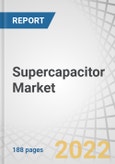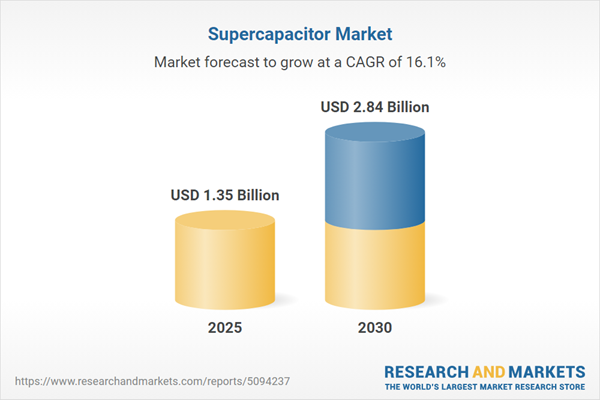Supercapacitors are deployed in backup power systems, voltage stabilization, and grid-side energy storage, especially in renewable integrations. In portable devices and IoT infrastructure, they offer quick charging, extended lifespan, and reliable performance. Technological advancements in electrode materials, particularly carbon-based and hybrid designs, improve energy density and expand their utility across broader applications. As industries increasingly prioritize electrification, efficiency, and resilience, the demand for high-performance supercapacitor solutions is set to grow significantly across diverse end-use segments.
Greater than 1,000 F segment is projected to exhibit the highest CAGR between 2025 and 2030.
The Greater than 1,000 F segment is expected to witness the highest CAGR during the forecast period, driven by its expanding role in applications that demand high energy buffering, rapid charge-discharge cycles, and extended service life. These high-capacitance supercapacitors are increasingly adopted in sectors such as grid energy storage, rail transportation, industrial automation, and backup power systems, where conventional batteries fall short in meeting surge power and longevity requirements. Their ability to deliver stable performance in extreme operating conditions and reduce maintenance needs makes them ideal for mission-critical and high-load environments.Additionally, ongoing efforts to integrate Greater than 1,000 F into hybrid energy systems, particularly in microgrids and regenerative braking solutions, further accelerate their adoption. The growth is also supported by investments in large-format supercapacitor modules designed to handle higher voltages and energy throughput in compact form factors. As industries prioritize efficiency, uptime, and power reliability, this segment is set to witness the strongest growth trajectory.
Automotive & transportation segment to account for the largest share of the supercapacitor market during the forecast period.
The automotive & transportation segment is projected to lead the supercapacitor market during the forecast period, fueled by the rising demand for efficient energy storage and rapid power delivery in electric and hybrid vehicles. Supercapacitors are increasingly integrated into vehicle systems for functions such as regenerative braking, start-stop systems, and power stabilization, offering advantages over traditional batteries in terms of longer lifecycle, higher power density, and superior low-temperature performance.In commercial fleets, railways, and electric buses, supercapacitors enable rapid energy recovery and short charging cycles, aligning with global efforts to reduce emissions and enhance fuel economy. The shift toward electrification, supportive government regulations, and investment in sustainable mobility infrastructure creates substantial growth opportunities for supercapacitor technologies. As OEMs prioritize lightweight, high-efficiency energy systems, the segment is expected to lead the market.
Asia Pacific is expected to register the highest CAGR in the supercapacitor market from 2025 to 2030.
Asia Pacific is expected to register the highest CAGR in the supercapacitor market during the forecast period, fueled by accelerating industrial activity, growing demand for energy-efficient technologies, and rising adoption of electric vehicles (EVs). Countries such as China, Japan, South Korea, and India are at the forefront of deploying supercapacitors across key sectors, including transportation, consumer electronics, and renewable energy.China, being the global leader in EV production and battery manufacturing, is significantly contributing to the regional demand. At the same time, Japan and South Korea continue to invest in high-performance energy storage technologies. Meanwhile, the electrification of public transport systems and grid modernization efforts in Southeast Asia further enhance the regional outlook. The availability of skilled manufacturing hubs and expanding domestic consumption of portable electronics and automotive technologies position Asia Pacific as a key driver for supercapacitor market expansion over the coming years.
Breakdown of primaries
Various executives from key organizations operating in the Supercapacitor market were interviewed in-depth, including CEOs, marketing directors, and innovation and technology directors.- By Company Type: Tier 1 - 45%, Tier 2 - 35%, and Tier 3 - 20%
- By Designation: Directors - 45%, C-level - 30%, and Others - 25%
- By Region: Asia Pacific - 45%, North America - 25%, Europe - 20%, and RoW - 10%
Major players profiled in this report are as follows: Maxwell Technologies (US), LS Materials (South Korea), Nippon Chemi-Con Corporation (Japan), Eaton (Ireland), CAP-XX (Australia), Nantong Jianghai capacitor Co., Ltd.(China), KYOCERA AVX Components Corporation (US), KEMET Corporation (US), Tecate Group (US), Cornell Dubilier (US), IOXUS (US), Skeleton Technologies (Estonia), KORCHIP CORPORATION (South Korea), Jinzhou Kaimei Power Co.Ltd (China), ELNA CO., LTD. (Japan), SCHURTER (Switzerland), Zhongtian Supercapacitor Technology Co., Ltd. (China), VINATech Co.,Ltd. (South Korea), Würth Elektronik eiSos GmbH & Co. KG (Germany), AOWEI TECHNOLOGY Shanghai (China), Wuxi CRE New Energy Technology Co., Ltd. (China), SPEL TECHNOLOGIES PRIVATE LIMITED (India), shenzhen chuangshiding electronics co.,ltd, (China), Shanghai Green Tech Co.,Ltd. (China) and Keltron Component Complex Ltd (India). These leading companies possess a wide portfolio of products, establishing a prominent presence in established as well as emerging markets.
The study provides a detailed competitive analysis of these key players in the supercapacitor market, presenting their company profiles, most recent developments, and key market strategies.
Research Coverage
In this report, the supercapacitor market has been segmented based on type, capacitance range, end user, and region. The type segment includes electric double layer capacitors (EDLCs) and hybrid capacitors. The capacitance range segment is categorized into Less than 100 F, 100-1,000 F, and Greater than 1,000 F. Based on end users, the market is segmented into consumer electronics, automotive & transportation, energy & power, industrial, and other end users (aerospace and medical devices). The regional analysis covers North America, Europe, Asia Pacific, and RoW.Reasons to buy the report
The report will help the leaders/new entrants in this market with information on the closest approximations of the revenue numbers for the overall market and the sub-segments. This report will help stakeholders understand the competitive landscape and gain more insights to position their businesses better and plan suitable go-to-market strategies. The report also helps stakeholders understand the supercapacitor market’s pulse and provides information on key market drivers, restraints, challenges, and opportunities.Key Benefits of Buying the Report
- Analysis of key drivers (Rising EV Adoption, Rising Demand for Fast-Charging Energy Storage Solutions, Increased Adoption in Renewable Energy Systems, Rising Industrial Automation and Robotics, High Power Density Enabling Instantaneous Energy Delivery), restraints (Limited Suitability for Long-Term Energy Storage, High Initial Cost Compared to Batteries), opportunities (Expanding Integration of Supercapacitors in Next-Generation Aircraft Systems, Rising Use of Supercapacitors as a Sustainable Alternative to Conventional Batteries, Advancements in Materials and Manufacturing Technologies, Emerging Applications in Wearables and IoT Devices), and challenges (Lack of Standardization Across Manufacturers, Temperature Sensitivity and Durability Concerns) influencing the growth of the supercapacitor market.
- Product Development/Innovation: Detailed insights on upcoming technologies, research and development activities, and new product launches in the supercapacitor market.
- Market Development: Comprehensive information about lucrative markets-the report analyses the supercapacitor market across varied regions.
- Market Diversification: Exhaustive information about new products/services, untapped geographies, recent developments, and investments in the supercapacitor market.
- Competitive Assessment: In-depth assessment of market shares, growth strategies, and service offerings of leading players, such as Maxwell Technologies (US), LS Materials (South Korea), Nippon Chemi-Con Corporation (Japan), Eaton (Ireland), and CAP-XX (Australia).
Table of Contents
Companies Mentioned
- Maxwell Technologies
- Ls Materials
- Nippon Chemi-Con Corporation
- Eaton
- Cap-Xx
- Tecate Group
- Cornell Dubilier
- Ioxus
- Skeleton Technologies
- Korchip Corporation
- Nantong Jianghai Capacitor Co. Ltd.
- Kyocera Avx Components Corporation
- Kemet Corporation
- Spel Technologies Private Ltd.
- Vinatech Co. Ltd.
- Keltron Component Complex Ltd.
- Wuxi Cre New Energy Technology Co. Ltd.
- Jinzhou Kaimei Power Co.Ltd.
- Shenzhen Chuangshiding Electronics Co.,Ltd.
- Elna Co. Ltd.
- Aowei Technology Shanghai
- Zhongtian Supercapacitor Technology Co. Ltd.
- Schurter
- Shanghai Green Tech Co. Ltd.
- Würth Elektronik Eisos GmbH & Co. KG
Table Information
| Report Attribute | Details |
|---|---|
| No. of Pages | 215 |
| Published | August 2025 |
| Forecast Period | 2025 - 2030 |
| Estimated Market Value ( USD | $ 1.35 Billion |
| Forecasted Market Value ( USD | $ 2.84 Billion |
| Compound Annual Growth Rate | 16.1% |
| Regions Covered | Global |
| No. of Companies Mentioned | 25 |









